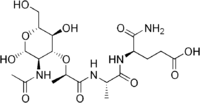 | |
| Names | |
|---|---|
| IUPAC name
(4R)-4-[ [(2S)-2-[ [(2R)-2-[(2R,5S)-3-acetamido-2,5-dihydroxy-6-(hydroxymethyl)oxan-4-yl]oxypropanoyl]amino]propanoyl]amino]-5-amino-5-oxopentanoic acid | |
| Other names
Acetylmuramyl-Alanyl-Isoglutamine | |
| Identifiers | |
3D model (JSmol) |
|
| ChemSpider | |
| ECHA InfoCard | 100.053.343 |
| MeSH | Muramyl+dipeptide |
PubChem CID |
|
| UNII | |
CompTox Dashboard (EPA) |
|
| |
| |
| Properties | |
| C19H32N4O11 | |
| Molar mass | 492.47758 |
Except where otherwise noted, data are given for materials in their standard state (at 25 °C [77 °F], 100 kPa).
Infobox references | |
Muramyl dipeptide is constituent of both Gram-positive and Gram-negative bacteria composed of N-acetylmuramic acid linked by its lactic acid moiety to the N-terminus of an L-alanine D-isoglutamine dipeptide.[1]
It can be recognized by the immune system as a pathogen-associated molecular pattern and activate the NALP3 inflammasome which in turn leads to cytokine activation, especially IL-1α and IL-1β.[2]
See also
- Dipeptide
- Mifamurtide, a synthetic analogue for the treatment of osteosarcoma
References
- ↑ Inohara N, Ogura Y, Fontalba A, Gutierrez O, Pons F, Crespo J, et al. (February 2003). "Host recognition of bacterial muramyl dipeptide mediated through NOD2. Implications for Crohn's disease". The Journal of Biological Chemistry. 278 (8): 5509–5512. doi:10.1074/jbc.C200673200. PMID 12514169.
- ↑ Martinon F, Agostini L, Meylan E, Tschopp J (November 2004). "Identification of bacterial muramyl dipeptide as activator of the NALP3/cryopyrin inflammasome". Current Biology : CB. 14 (21): 1929–1934. doi:10.1016/j.cub.2004.10.027. PMID 15530394.
This article is issued from Wikipedia. The text is licensed under Creative Commons - Attribution - Sharealike. Additional terms may apply for the media files.